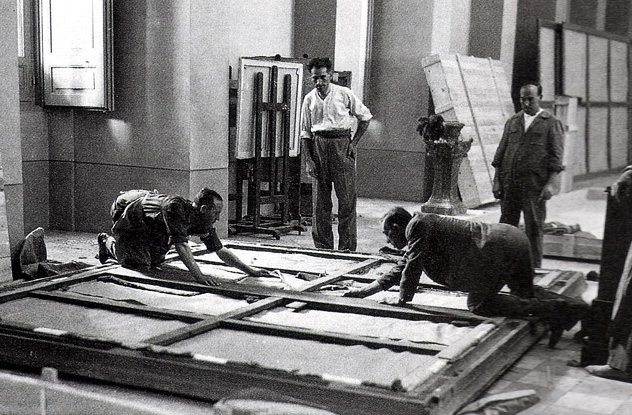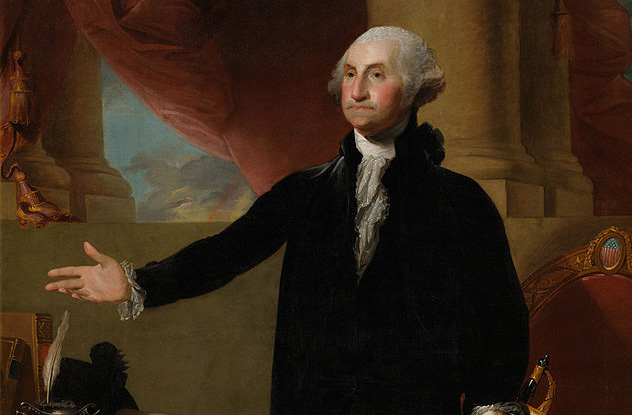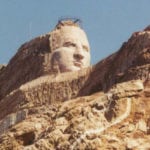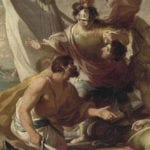 Misconceptions
Misconceptions  Misconceptions
Misconceptions  History
History 10 Amazing Roman Epitaphs
 Weird Stuff
Weird Stuff 10 Niche Subcultures That Are More Popular Than You Might Think
 Mysteries
Mysteries 10 Tragic Disappearances and Deaths in Joshua Tree National Park
 History
History 10 Ways Childhood Really Sucked in the Old West
 Music
Music 10 Name Origins of Famous Bands from the 1990s
 Religion
Religion 10 Biggest Turnarounds by the Catholic Church
 Weird Stuff
Weird Stuff 10 Unbelievable Times Laws Had Unintended Consequences
 Humans
Humans Ten Historic Women Who Deserve Way More Credit Than They Got
 Movies and TV
Movies and TV 10 Films That Spawned Major Lawsuits
 Misconceptions
Misconceptions 10 Phony Myths and Urban Legends That Just Won’t Die
 History
History 10 Amazing Roman Epitaphs
 Weird Stuff
Weird Stuff 10 Niche Subcultures That Are More Popular Than You Might Think
Who's Behind Listverse?

Jamie Frater
Head Editor
Jamie founded Listverse due to an insatiable desire to share fascinating, obscure, and bizarre facts. He has been a guest speaker on numerous national radio and television stations and is a five time published author.
More About Us Mysteries
Mysteries 10 Tragic Disappearances and Deaths in Joshua Tree National Park
 History
History 10 Ways Childhood Really Sucked in the Old West
 Music
Music 10 Name Origins of Famous Bands from the 1990s
 Religion
Religion 10 Biggest Turnarounds by the Catholic Church
 Weird Stuff
Weird Stuff 10 Unbelievable Times Laws Had Unintended Consequences
 Humans
Humans Ten Historic Women Who Deserve Way More Credit Than They Got
 Movies and TV
Movies and TV 10 Films That Spawned Major Lawsuits
10 Courageous Ways People Saved Treasures From Wars And Repression
The first casualty of war may or may not be truth, but the second is definitely culture. As you read this, ISIS’s goons are busy trashing Iraq’s heritage, while the Syrian Civil War has already demolished six World Heritage sites.
Yet it doesn’t have to be this way. Throughout the world, brave individuals have risked life and limb to conserve our greatest treasures. Sometimes, they’re professionals, like the Monuments Men. But mostly, they’re just ordinary folks who looked at the cultural vandalism unfolding around them and said “not today.” Here are their stories.
10The Syrian Archaeologists Defying ISIS
On one side is a force of murderous fundamentalists with more firepower than many armies. On the other is a tiny group of polite, gray-haired scholars. Yet Syria’s archaeologists have managed to thwart ISIS multiple times now, saving priceless treasures in the process.
It all started back in 2012. At the time, Assad’s forces were laying siege to the city of Maarat. A combination of barrel bombs and rebel shells were destroying entire neighborhoods, and it looked as if the city’s museum would go at any minute. Working in the US, Professor Al-Azm decided he couldn’t let this happen. He assembled archaeology’s answer to the Avengers—a group of ragtag volunteers and academics he dubbed “Syria’s Monuments Men.” They then traveled from Turkey deep into the heart of the war, where they preserved the museum’s ancient mosaics by concealing them behind concrete and filling the room with shrapnel-absorbing sandbags.
It was incredibly dangerous work and only got worse when ISIS arrived. Like the cultural supervillains they are, the terror group have made demolishing and looting ancient sites one of their main priorities. Since summer 2014, Al-Azm’s brainy superheroes have been risking violent execution to photograph treasures in the Islamic State before they’re snatched, so dealers can recognize the goods on the black market. A similar tactic used in Pakistan and Afghanistan resulted in 1,500 irreplaceable objects being saved. If Azm and his team can do the same, they may well single-handedly preserve Syria’s heritage.
9The Ordinary People Keeping Culture Alive In Donetsk
Since summer 2014, Donetsk in Eastern Ukraine has been the epicenter of some of the fiercest fighting on Earth. Thousands have died and hundreds of thousands fled as pro-Putin rebels and the Ukrainian army face off in a bloody deadlock. Yet a small group of determined residents have not only stayed—they’ve managed to keep a flicker of culture alive.
At the Donetsk Regional History Museum, a group of workers have continued to clock in every day to keep the collection safe from the fighting. Their work is far from easy. The museum has been shelled repeatedly. Civilians have been killed in the streets. Despite this, the team have managed to save 150,000 pieces and even organize small exhibitions in local schools.
Meanwhile, the unpaid staff at the Donetsk Opera have staged two shows and a children’s ballet in an attempt to keep the city’s cultural life alive. In an interview with the Toronto Globe and Mail, the opera’s director said, “People fight their stress through theater. We’re helping them psychologically.”
8Somalia’s Last Archaeologist
Since 1991, Somalia has been mired in an ongoing civil war that’s left the country lawless. As many as one million people have died, thanks to vicious fighting and devastating famines. Unsurprisingly, most people who find themselves in the country are interested in nothing more than surviving. Dr. Sada Mire isn’t most people. For years now, she’s been traveling into one of the worst places on Earth, with the simple goal of preserving and cataloguing its archaeological treasures.
This is even less likely than you’d think. When Sada Mire was 14, she was nearly killed when a bomb exploded while she was watering her family’s garden in Mogadishu. As the country went to hell around them, her mother had to smuggle her teenage daughter through territory crawling with bandits and rapists. Given asylum in Sweden, the young Mire decided she would make it her life’s work to return to Somalia and uncover its history.
Although primarily based in Somaliland, a comparatively stable self-declared state in the north, Dr. Mire has made several cross-border runs into the south. During this time, she’s uncovered a dozen new sites the BBC calls candidates for UNESCO World Heritage status. Armed only with her specialist knowledge and a significant amount of courage, Dr. Mire has single-handedly preserved ancient Somali culture for future generations.
7The Doctor Who Fan Risking His Life To Save British TV
It’s not unusual to hear obsessives say they’d “die” for their favorite TV show. Only one man really means it. Meet Phillip Morris. For the past half-decade or so, he’s traveled to some of the most dangerous regions on Earth, risking life and limb to recover the BBC’s missing Doctor Who episodes.
His strange quest started in the Niger Delta in 2006, when Morris was taken hostage by armed guerrillas. In a desperate attempt to win over his captors, he emulated the behavior and mannerisms of the man who played the Doctor when he was a boy in the 1970s: Tom Baker. Unbelievably, it worked. According to Morris, taking on the Doctor’s persona saved his life. When he was finally released, he decided to return the favor.
Thanks to an obsession with cost-cutting, the BBC famously wiped over 100 episodes of Doctor Who. Morris set out and find these, a journey that took him to some very extreme places. In Syria, he came within seconds of having a shell blow him to pieces. In regions of Africa, he encountered warlords and militias. He even returned to the site of his kidnapping to see if any episodes had turned up there. In 2013, he successfully returned nine missing episodes to the BBC archives, before vanishing off again to continue his quest. The job has earned him the nickname “the Indiana Jones of TV,” a name we’re going to say he fully deserves.
6Saving Music From Soviet Censorship
One of Nikita Khrushchev’s first acts as Soviet leader was to order the building of private apartments for each family. Prior to that, Russian families had lived in communal blocks, where everyone shared rooms, toilets, and kitchens. The Khrushchev decree aimed to make life a little more livable for Russians. It wound up fomenting a sound revolution.
Under Stalin, privacy was impossible. If you listened to dissident music, everyone would know, and you’d be carted off to the nearest gulag faster than you could say “repression.” The new Khrushchev apartments offered a space for listening to anything you wanted to—provided you could get hold of it. This is where the X-ray collectors came in.
In 1950s USSR, the only format available was vinyl. Unfortunately, records were rare and reserved for the party higher-ups. The collectors—young Russians who scoured hospital bins for discarded X-rays—realized you could imprint a vinyl recording on an old slice of X-ray film. Since this was illegal anyway, they could record what they wanted. And what they wanted was American rock.
Before the KGB knew what was happening, hundreds of these X-ray records were passing through Russian apartments. People listened to them in secret, passed them on, and inspired one another with banned American culture. As time wore on, they began to collect the banned music of Russian folksingers, too, keeping traditions alive even in the face of Soviet censorship. Dissident composer Yuliy Kim later credited these secret recordings with spreading subversive thought throughout the Soviet Union, paving the way for the empire’s eventual collapse.
5Saving Priceless Art From Franco’s Bombs

On July 17, 1936, General Francisco Franco launched a coup in Spanish-controlled Morocco. It marked the start of the Spanish Civil War, a war that would lead to concentration camps, torture, Roman-style arena executions, and mayhem. Almost immediately, both sides launched a campaign of looting and cultural destruction equal to anything the Nazis did. Churches were burned by leftists; art galleries were bombed by Franco’s men. Against them both stood the Committee for Artistic Treasures.
Described as “a kind of artistic Red Cross,” the committee was mostly made up of civilians given dispensation by the Republican government to save whatever they could. As carnage unfolded on an unprecedented scale around them, the committee calmly requisitioned a vast church and began stuffing it full of Spain’s irreplaceable heritage.
In a show of solidarity, they didn’t just save the works Republicans approved of. Church artifacts dear to Franco were also removed from targeted buildings and taken to safety. As the bombs approached Madrid, the committee took the works on the road, into the heart of the war. First, they guided them safely to Valencia, then to Catalonia, and finally to Geneva, where the League of Nations guaranteed them protection. Thanks to the work of these ordinary civilians, thousands of masterpieces by geniuses like Goya, Picasso, and Titian were saved.
4The Ordinary Joes Who Saved A Nation’s Greatest Portrait

If you know anything about American history, you know about the Lansdowne portrait. A painting of George Washington by Gilbert Stuart, it’s possibly the most iconic image of a president ever painted. Nearly destroyed when the British torched the White House, it was only saved thanks to the quick thinking of First Lady Dolley Madison. But there’s another, more inspiring version of events. The portrait was saved by two ordinary Joes.
This version of the tale comes courtesy of Paul Jennings, a slave who worked for President Madison. In 1865, he wrote about the British attack on the capital, claiming that Dolley Madison’s role in saving the portrait had been greatly exaggerated. According to Jennings’s version of events, Dolley was too busy saving the silver to be bothered with a painting. Instead, the task fell to two ordinary men: John Sioussat and Thomas McGraw.
A steward and a gardener, Sioussat and McGraw were nobody special. They were also in fear of their lives, as the British were due any minute. Nonetheless, they kept their cool just long enough to cut the painting from its frame and get it onto a wagon to safety. If Jennings is to be believed, this would mean an irreplaceable piece of American culture was saved not by some great leader but two normal folk who risked their lives for a symbol of the land they loved.
3The Booksellers Who Preserved Sudan’s Literary Heritage
In 1989, Colonel Omar Al-Bashir overthrew the elected Sudanese government in a bloody coup that killed tens of thousands. What followed was an extensive crackdown on civil liberties that saw political parties banned and newspapers outlawed. There was also a concerted effort to ban books and eliminate libraries, killing Khartoum’s history of literary pedigree. At least, it would have were it not for a few secondhand booksellers.
While most booksellers closed up shop in the aftermath of the coup, a small number went underground. There, they created a flourishing trade in black market paperbacks, keeping the work of writers like Tayeb Salih, Abbas El-Aqqad, and Nizar Qabbani alive. At its height, the trade was similar to Prohibition-era America. As poet and journalist Mamoun Eltlib recalled, hunting for books in early 1990s Khartoum relied solely on contacts. Once you had managed to get an address, you would travel to a dark back alley of the city, where a man would question you. If you were lucky, he’d pull up a floorboard and hand over a few precious pages.
Although some of these sellers were purely in it for the money, it was dangerous work, and many risked their lives. It was worth it. Today, Eltlib credits this trade with having saved Sudan’s literary culture in the face of a repressive new dictatorship.
2The Villagers Protecting Syria’s Neglected Treasure

In some ways, the villagers of Tell Brak have been lucky. Although they live on the wrong side of the Turkish border to escape the Syrian Civil War, fighting hasn’t yet reached their town. In other ways, they’ve been spectacularly unlucky. A combination of sanctions and regime collapse has left them desperately poor and unable to get vital supplies. Yet even in these circumstances, they’ve still managed to protect one of Syria’s greatest treasures: the mound of Tell Mozan.
An ancient city not yet fully excavated, Tell Mozan appears to be the site of a unique urban culture that formed alongside that of Mesopotamia. If it survives the war, it has the potential to be one of the most historically valuable sites on Earth. The villagers of Tell Brak are making sure it does.
In the face of poverty, harsh weather, and the ever-present threat of war, groups of local volunteers are providing Tell Mozan with round-the-clock security. They’re also paying for the site’s upkeep from their own pockets—something that’s doubly impressive when you realize food and medicine are now rare and expensive. Even as most are fleeing the oncoming war, a handful have stayed in place, determined to protect their heritage. Thanks to their efforts, it seems likely Tell Mozan will avoid the fate of many of Syria’s ancient sites.
1The Afghan Workers Undoing The Taliban’s Cultural Vandalism

Before ISIS stole their crown, the world’s foremost cultural vandals were the Taliban. In 2001, they famously blew up two ancient Buddha statues. They also destroyed many lesser sites, a spree of vandalism exacerbated by the war. But not everyone in Afghanistan supported their efforts. For the past decade, a loose-knit team of ordinary Afghan construction workers has been traveling the country, undoing the Taliban’s damage.
It all started when Khan Ali was contracted to stabilize the remains of the Buddha statues at Bamiyan. Supplied with funds from UNESCO, the former-bricklayer spent a year learning new techniques, becoming a restoration expert in the process. Once his job was done in Bamiyan, Ali took his new talents on the road. His mission: to restore Afghanistan’s damaged heritage.
Since then, Ali has helped rebuild, restore, and save dozens of Afghanistan’s priceless treasures. Along with a handful of other newly trained experts, he’s worked on the ancient Shahr-e Gholghola citadel and many minor sites dotted around the country. In doing so, he’s helped reverse the damage of a decade and a half of war and save treasures the Taliban thought worthless. Ali and the other experts may not quite be capable of rebuilding the Bamiyan Buddhas, but thanks to their efforts, future generations will now be able to enjoy Afghanistan’s priceless cultural heritage.








